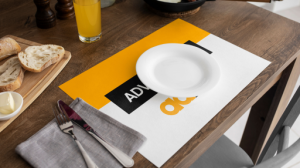Placemat advertisements are gaining traction as a cost-effective and high-visibility marketing tool, particularly in the restaurant and hospitality sectors. However, many marketers struggle with quantifying their return on investment (ROI) from these campaigns. Unlike digital marketing, where metrics like clicks and impressions are readily available, tracking the effectiveness of placemat advertisements requires a combination of strategic planning and data analysis.
In this article, we’ll explore how to measure ROI in placemat advertising, including key performance indicators (KPIs), tracking methods, and best practices for optimizing your campaigns.
Understanding ROI in Placemat Advertising
Return on investment (ROI) is a fundamental metric for any marketing campaign. In the context of placemat advertisements, ROI measures how effectively these ads convert into brand awareness, customer engagement, and ultimately, revenue.
Formula for ROI:

To apply this formula to placemat advertising, we must first establish reliable methods for attributing sales and customer actions to the campaign.
Key Performance Indicators (KPIs) for Placemat Advertising ROI
To effectively track and measure the success of placemat advertisements, marketers should focus on the following KPIs:
1. Customer Engagement and Brand Recall 
Conduct surveys or interviews with customers to gauge whether they recall the ad.
Utilize QR codes or promo codes unique to the placemat campaign to measure direct engagement.
2. Redemption Rates on Promotional Offers
Include special discounts, coupons, or promo codes on placemat advertisements to track how many customers redeem them.
Compare redemption rates across different locations or time periods to determine effectiveness.
3. Website Traffic and Online Conversions
Use custom URLs, UTM parameters, and QR codes to drive traffic from placemat ads to your website.
Monitor Google Analytics for spikes in traffic from locations where placemat ads are distributed.
4. Increased Sales and Revenue Lift
Compare sales data before, during, and after the campaign to determine whether placemat advertisements contributed to increased revenue.
Use POS (Point of Sale) systems to track customer behavior and purchases linked to the ad.
5. Customer Foot Traffic and Dwell Time
Measure whether customers spend more time at tables that feature placemat advertisements.
Partner with restaurant staff to track new customer inquiries or direct responses to the advertisement.
Methods to Track ROI in Placemat Advertising
Unlike digital ads, which provide direct attribution, placemat advertising requires creative tracking methods. Here are some of the most effective ways to measure ROI:
1. QR Codes for Digital Engagement
Embedding QR codes in placemat advertisements allows for precise tracking of engagement. By directing customers to a landing page, survey, or promotional offer, marketers can track:
Click-through rates (CTR)
Page visits
Lead conversions
2. Unique Promo Codes or Discount Offers
Using distinct promo codes on placemats helps measure how many customers make a purchase based on the ad. This method directly links in-store and online conversions to the campaign.
3. Customer Surveys and Feedback Forms
Conduct on-site or online surveys asking customers if they noticed the advertisement and whether it influenced their purchase decision.
4. Call Tracking with Custom Phone Numbers
If your business relies on phone inquiries, use a unique phone number on placemat advertisements to track incoming calls generated by the campaign.
5. Social Media Engagement and Hashtags
Encourage customers to take action by including a branded hashtag in the ad. Track social mentions and interactions linked to the campaign to assess engagement.
Best Practices for Maximizing ROI from Placemat Advertisements
To ensure you get the most out of your placemat advertising campaign, consider these optimization strategies:
1. Strategic Placement for Maximum Exposure 
Choose high-traffic restaurants or cafés where your target audience frequently dines.
Partner with businesses that align with your brand to increase relevancy.
2. Compelling and Actionable Ad Design
Use bold visuals and easy-to-read messaging.
Include a strong call-to-action (CTA) that encourages immediate response (e.g., “Scan this QR code for 10% off!”).
3. A/B Testing for Ad Variations
Test different ad designs, messages, and offers to identify what resonates most with customers.
Compare performance across different locations to refine your approach.
4. Cross-Promotion with Digital Channels
Integrate placemat ads with social media and email marketing to create a multi-touchpoint campaign.
Encourage customers to follow your brand online for additional incentives.
5. Track Data Over Time for Better Insights
Collect and analyze data over several months to identify trends.
Use insights to refine future campaigns and maximize effectiveness.









